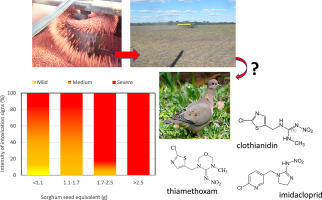Science of the Total Environment ( IF 8.2 ) Pub Date : 2018-09-10 , DOI: 10.1016/j.scitotenv.2018.09.112
Laura M. Addy-Orduna , Julie C. Brodeur , Rafael Mateo

|
Neonicotinoids have recently been demonstrated to cause direct negative impacts on birds from North America and Europe. To further understand the impact of these compounds on bird species and to improve risk assessment capacities, the current study determined the acute toxicities of imidacloprid, clothianidin, and thiamethoxam formulations on South American eared doves (Zenaida auriculata). Insecticides were administered by gavage to adult doves to determine median lethal doses (LD50) according to a standardized sequential procedure. The acute toxicity of formulated imidacloprid (LD50 = 59 mg active ingredient, a.i./kg body weight, b.w.) was much higher than that of the tested formulations of clothianidin (LD50 = 4248 mg a.i./kg b.w.) and thiamethoxam (LD50 = 4366 mg a.i./kg b.w.). Imidacloprid also differed from the other two neonicotinoids in terms of the onset and intensity of intoxication signs and the times of death and recovery. All three insecticides induced a reduction in food consumption that led to body weight loss. An average weight dove of 127 g would obtain a dose equivalent to the LD50 of imidacloprid by consuming 1.7 g of treated sorghum seeds. As eared doves offered non-treated sorghum seeds 5 h per day consumed on average 6.4 ± 1.8 g (mean ± S.D.), it is concluded that these doves could feasibly be exposed to lethal doses in the field. This work is the first to describe intoxication signs and report oral neonicotinoid LD50s in a wild South-American bird species.
中文翻译:

吡虫啉,噻虫嗪和可比丁对有耳鸽子的口服急性毒性:对鸟类中新烟碱类药物风险评估的贡献
最近,新烟碱类药物已被证明会对北美和欧洲的鸟类造成直接的负面影响。为了进一步了解这些化合物对鸟类的影响并提高风险评估能力,当前的研究确定了吡虫啉,可比安定和噻虫嗪制剂对南美有耳鸽子(Zenaida auriculata )的急性毒性。杀虫剂根据标准化连续程序,通过管饲法对成年鸽子给药,以确定中位致死剂量(LD50)。吡虫啉制剂(LD50 = 59 mg有效成分,ai / kg体重,bw)的急性毒性远远高于被测试的噻虫胺制剂(LD50 = 4248 mg ai / kg bw)和噻虫嗪(LD50 = 4366 mg)的急性毒性。 ai / kg bw)。吡虫啉在中毒症状的发作和强度以及死亡和恢复的时间方面也与其他两种新烟碱类药物不同。所有这三种杀虫剂均导致食物消耗减少,从而导致体重减轻。平均重量为127克的鸽子将获得等效的剂量通过消耗1.7 g处理过的高粱种子使吡虫啉的LD50降低。由于有耳鸽子每天未经处理的高粱种子每天消耗5个小时,平均消耗6.4±1.8 g(平均±标准差),因此可以得出结论,这些鸽子可能在田间接触致命剂量。这项工作是第一个描述中毒症状并报告南美野生鸟类口服新烟碱类LD50的研究。







































 京公网安备 11010802027423号
京公网安备 11010802027423号